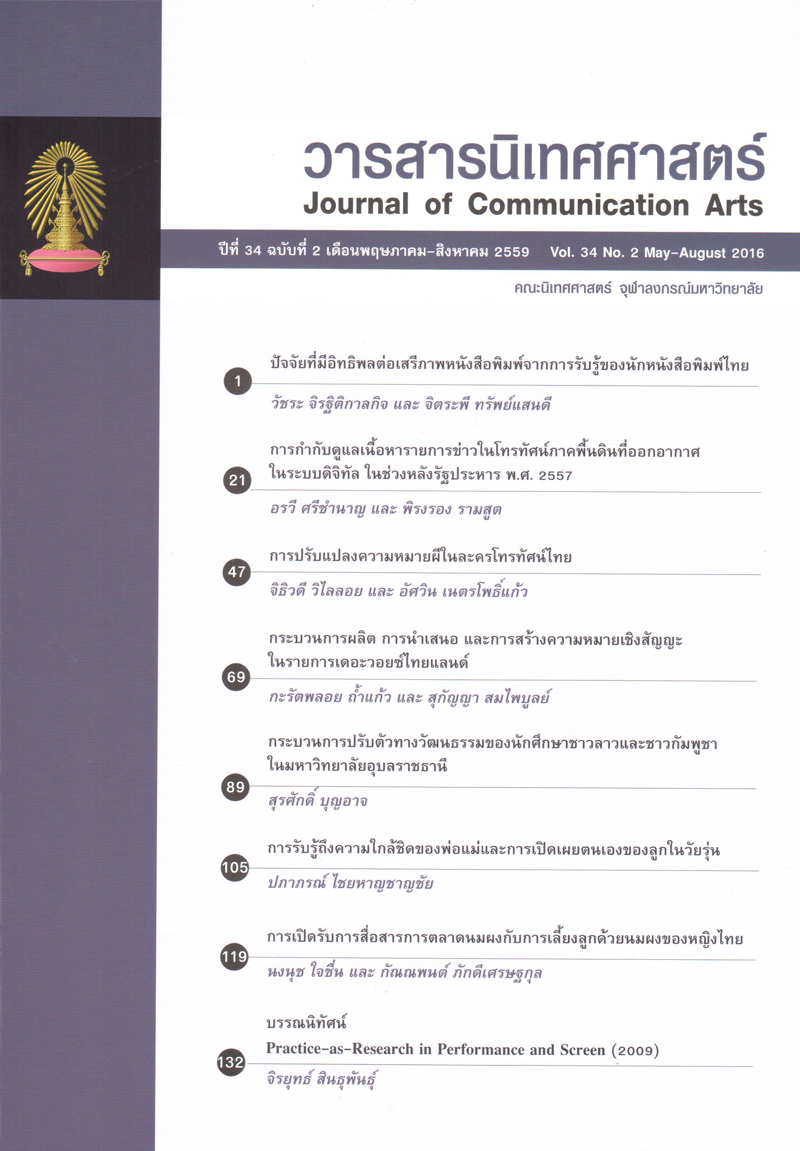ปัจจัยที่มีอิทธิพลต่อเสรีภาพหนังสือพิมพ์ จากการรับรู้ของนักหนังสือพิมพ์ไทย
Main Article Content
Abstract
การวิจัยนี้มีวัตถุประสงค์เพื่อศึกษาองค์ประกอบตัวชี้วัดเสรีภาพหนังสือพิมพ์ไทย ปัจจัยที่มีอิทธิพลต่อเสรีภาพหนังสือพิมพ์ไทยและพัฒนาโมเดลความสัมพันธ์เชิงสาเหตุ โดยใช้ระเบียบวิธีวิจัยแบบนำ-แบบรอง ได้แก่ 1) การพัฒนาตัวชี้วัดและปัจจัยที่มีอิทธิพลต่อเสรีภาพหนังสือพิมพ์ไทยใช้การวิจัยเชิงคุณภาพด้วยการวิเคราะห์เอกสารประกอบการสัมภาษณ์นักหนังสือพิมพ์ระดับบริหาร ระดับปฏิบัติการและนักวิชาการด้านนิเทศฯ 2) การพัฒนาโมเดลความสัมพันธ์เชิงสาเหตุใช้การวิจัยเชิงปริมาณด้วยการวิจัยเชิงสำรวจนักหนังสือพิมพ์ไทย จำนวน 424 ราย จากนั้นวิเคราะห์ข้อมูลด้วยการวิเคราะห์องค์ประกอบเชิงสำรวจ การวิเคราะห์องค์ประกอบเชิงยืนยันอันดับที่สองและการวิเคราะห์เส้นทางอิทธิพลของโมเดลลิสเรล
ผลการวิจัยพบว่า 1. โมเดลองค์ประกอบของตัวชี้วัดเสรีภาพหนังสือพิมพ์ไทยมีความสอดคล้องกับข้อมูลเชิงประจักษ์ (Chi-square=425.097 df=380 p=0.055 GFI=0.948 AGFI=0.909 RMR=0.032 RMSEA=0.017) ประกอบด้วยองค์ประกอบหลัก 4 ด้าน ได้แก่ 1) เสรีภาพในการปฏิบัติงานตามวิชาชีพหนังสือพิมพ์ 2) เสรีภาพในการได้รับการคุ้มครองในการทำหน้าที่ 3) เสรีภาพในการได้รับการส่งเสริมพัฒนาทางวิชาชีพและ 4) เสรีภาพในการกำกับดูแลตนเอง รวม 36 ตัวชี้วัด 2. โมเดลความสัมพันธ์เชิงสาเหตุมีความสอดคล้องกับข้อมูลเชิงประจักษ์ (Chi-square=235.971 df=210 p=0.106 GFI=0.968 AGFI=0.947 RMR=0.037 RMSEA=0.017) และอธิบายความแปรปรวนของเสรีภาพหนังสือพิมพ์ไทยได้ร้อยละ 50.3 โดยเสรีภาพหนังสือพิมพ์ไทยได้รับอิทธิพลจากจริยธรรม เศรษฐกิจ การเมือง กฎหมายและสังคมโดยมีค่าอิทธิพลเท่ากับ 0.497, 0.253, 0.214, 0.154 และ 0.103 ตามลำดับ
Thai journalist perceptions on factors influencing freedom of the press
The purpose of this research was to study freedom of the press indicators, factors influencing freedom of the press and developed causal relationship model. A Dominant-less Dominant Design was used, samples were 424 Thai journalists (print newspapers) who filled out questionnaires. In-depth interviews with key informants, who are editors, assignment journalists, and professors of journalism, also took place. Data was analyzed by inferential statistics with explanatory factor analysis (EFA), second-order confirmatory factor analysis (CFA) and the goodness-of-fit of a model to data was evaluated for path analysis by linear structural relations (LISREL).
Results were that freedom of the press model with four factors and 36 indicators were suitable to empirical data (Chi-square=425.097 df=380 p=0.055 GFI=0.948 AGFI=0.909 RMR=0.032 RMSEA=0.017). These included freedom to practice as professional journalists, freedom to be protected in journalistic acting, freedom to promote journalistic development, and freedom to self-regulate. In addition, the causal relationship model was valid, matching empirical data (Chi-square=235.971 df=210 p=0.106 GFI=0.968 AGFI=0.947 RMR=0.037 RMSEA=0.017) and influencing factors in the model could account for 0.503 of variance in freedom of the press (50.3%). Freedom of the press was influenced by journalistic ethics, economic, politics, law, and social with influence values 0.497, 0.253, 0.214, 0.154 and 0.103


